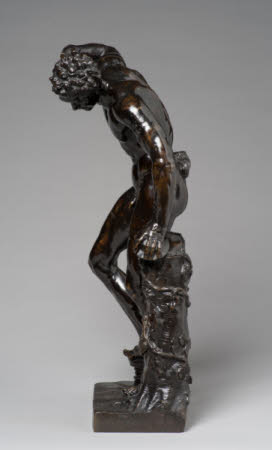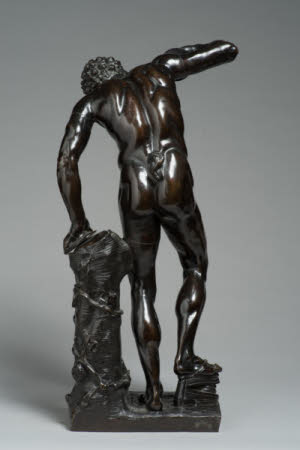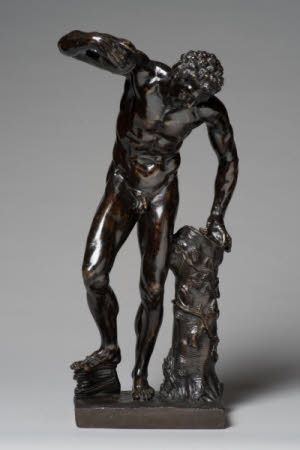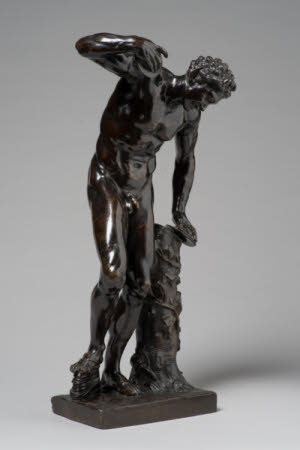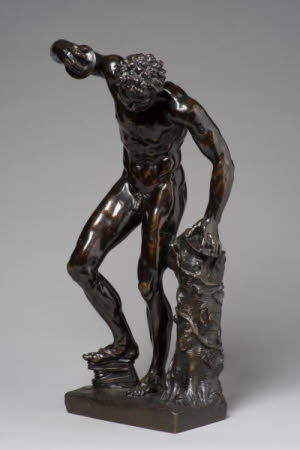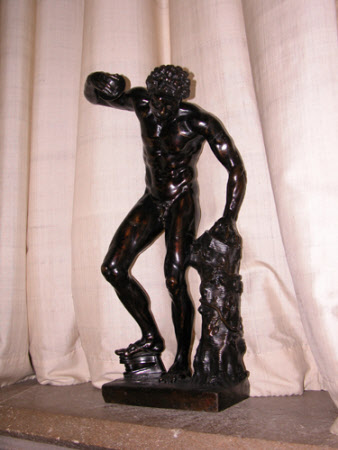The Dancing Faun
Italian (Florentine) School
Category
Art / Sculpture
Date
circa 1700 - circa 1730
Materials
Bronze
Measurements
517 x 250 x 203
Place of origin
Florence
Order this imageCollection
Anglesey Abbey, Cambridgeshire
NT 515043
Summary
Bronze, Dancing Faun, Italian (Florentine) School, after the antique, c. 1700-30. A bronze sculpture of a dancing faun, after the antique statue in the Uffizi, Florence. The naked figure of a male faun with small horns, pointed ears and small tail, holding a cymbal in each hand; he looks downwards towards his left, right foot placed on a scabellum (a type of foot-operated castanet). To his left a gnarled tree trunk encircled with ivy. Mounted on a rectangular base. The legs and base cast separately and joined after casting. Base much worked with tool. Remains of golden varnish under later blackish patination.
Full description
The antique marble statue known as the Dancing Faun probably entered the Medici collections in Florence around the mid-sixteenth century, although it is certainly recorded only in 1665. It was after its installation in 1688 in the Tribuna of the Uffizi that its merits became fully recognised, leading it to become one of the most admired of all Antique sculptures. In the eighteenth century, at the height of the Grand Tour, it had an extraordinary reputation. The English painter and writer Jonathan Richardson for example thought it ‘the best in the Tribuna . . . ’tis so light,’tis leaping off its Pedestal’ (Jonathan Richardson the Elder and Jonathan Richardson the Younger, An Account of some of the Statues, Bas-reliefs, Drawings and Pictures in Italy…, London 1722, p. 57), whilst the sculptor Massimiliano Soldani Benzi (1656-1740) described it to his patron the Prince of Liechtenstein as ‘the most beautiful statue to be found anywhere.’ (Letter of 9 July 1695; Klaus Lankheit, Florentinische Barockplastik. Die Kunst am Hof der letzten Medici 1670-1743, Munich 1962, p. 329, doc. 645). It is not surprising therefore that the statue was much copied, not least by Soldani, who made life-size versions in bronze for the Prince of Liechtenstein and the Duke of Marlborough, but also smaller versions, as part of a series of statuettes of ‘the most famous statues to be found in this city’, that he mainly sold to Grand Tourists. The Anglesey Abbey figure is not a product of Soldani’s workshop, but is very likely to have been made in another Florentine workshop in the first decades of the eighteenth century. Whereas the bronze versions made in Soldani’s workshop dispense with the tree trunk, necessary in a marble to ensure the statue’s stability but not needed for a bronze, it is retained in the Anglesey Abbey version of the Dancing Faun. However, the tree trunk, rather plain in the original marble, is here modelled in great naturalistic detail, the surface of the trunk carefully worked and a vine tendril trailed around it. The modelling and afterworking overall are of a high order. Jeremy Warren 2019
Provenance
Bequeathed to the National Trust by Huttleston Rogers Broughton, 1st Lord Fairhaven (1896-1966) with the house and the rest of the contents.
Credit line
Anglesey Abbey, The Fairhaven Collection (The National Trust)
Makers and roles
Italian (Florentine) School, sculptor
References
Christie, Manson & Woods 1971: The National Trust, Anglesey Abbey, Cambridge. Inventory: Furniture, Textiles, Porcelain, Bronzes, Sculpture and Garden Ornaments’, 1971, p. 137.
